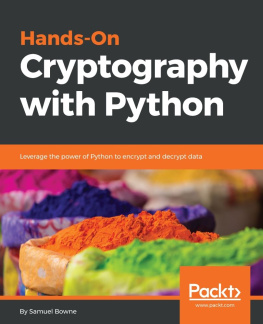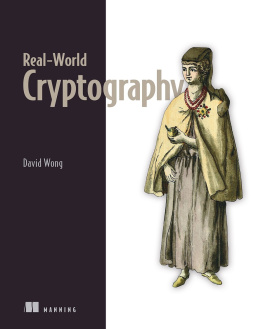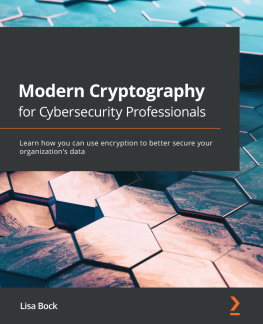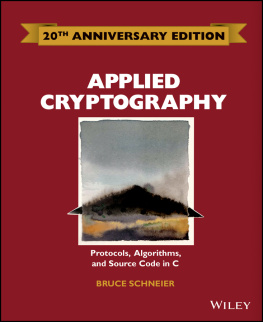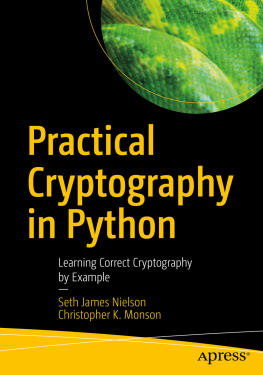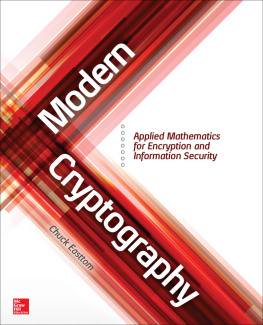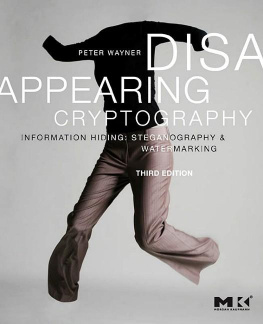Samuel Bowne - Hands-On Cryptography with Python: Leverage the Power of Python to Encrypt and Decrypt Data
Here you can read online Samuel Bowne - Hands-On Cryptography with Python: Leverage the Power of Python to Encrypt and Decrypt Data full text of the book (entire story) in english for free. Download pdf and epub, get meaning, cover and reviews about this ebook. year: 2018, publisher: Packt Publishing, genre: Home and family. Description of the work, (preface) as well as reviews are available. Best literature library LitArk.com created for fans of good reading and offers a wide selection of genres:
Romance novel
Science fiction
Adventure
Detective
Science
History
Home and family
Prose
Art
Politics
Computer
Non-fiction
Religion
Business
Children
Humor
Choose a favorite category and find really read worthwhile books. Enjoy immersion in the world of imagination, feel the emotions of the characters or learn something new for yourself, make an fascinating discovery.
- Book:Hands-On Cryptography with Python: Leverage the Power of Python to Encrypt and Decrypt Data
- Author:
- Publisher:Packt Publishing
- Genre:
- Year:2018
- Rating:5 / 5
- Favourites:Add to favourites
- Your mark:
Hands-On Cryptography with Python: Leverage the Power of Python to Encrypt and Decrypt Data: summary, description and annotation
We offer to read an annotation, description, summary or preface (depends on what the author of the book "Hands-On Cryptography with Python: Leverage the Power of Python to Encrypt and Decrypt Data" wrote himself). If you haven't found the necessary information about the book — write in the comments, we will try to find it.
Learn to evaluate and compare data encryption methods and attack cryptographic systems
Key Features- Explore popular and important cryptographic methods
- Compare cryptographic modes and understand their limitations
- Learn to perform attacks on cryptographic systems
Cryptography is essential for protecting sensitive information, but it is often performed inadequately or incorrectly.
Hands-On Cryptography with Python starts by showing you how to encrypt and evaluate your data. The book will then walk you through various data encryption methods,such as obfuscation, hashing, and strong encryption, and will show how you can attack cryptographic systems. You will learn how to create hashes, crack them, and will understand why they are so different from each other. In the concluding chapters, you will use three NIST-recommended systems: the Advanced Encryption Standard (AES), the Secure Hash Algorithm (SHA), and the Rivest-Shamir-Adleman (RSA).
By the end of this book, you will be able to deal with common errors in encryption.
What you will learn- Protect data with encryption and hashing
- Explore and compare various encryption methods
- Encrypt data using the Caesar Cipher technique
- Make hashes and crack them
- Learn how to use three NIST-recommended systems: AES, SHA, and RSA
- Understand common errors in encryption and exploit them
Hands-On Cryptography with Python is for security professionals who want to learn to encrypt and evaluate data, and compare different encryption methods.
Table of Contents- Obfuscation
- Hashing
- Strong Encryption
Samuel Bowne: author's other books
Who wrote Hands-On Cryptography with Python: Leverage the Power of Python to Encrypt and Decrypt Data? Find out the surname, the name of the author of the book and a list of all author's works by series.

